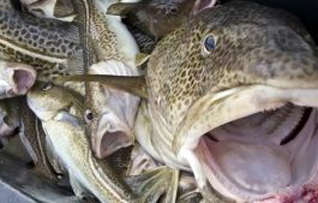 les of salmon in China fell 32 percent in volume to 8,597 metric tons (MT) (fresh and frozen) while value stayed flat thanks to a strong increase in Chinese prices in 2013.
les of salmon in China fell 32 percent in volume to 8,597 metric tons (MT) (fresh and frozen) while value stayed flat thanks to a strong increase in Chinese prices in 2013.Norway’s overall seafood exports to China rose 5 percent in volume to 164,000 MT, rising 15 percent in value, according to Sigmund Bjorgo, China head of the Norwegian Seafood Council (NSC). Salmon prices in China have grown more strongly that elsewhere, said Bjorgo: “There’s a shortage of large-sized fish, and Chinese are willing to pay a premium.”
Norway’s seafood sales in China were helped by shipments of cod, which soared 76 percent in volume terms to 44,000 MT — Bjorgo credits this to larger cod fishing quotas in Norway. In value terms however cod shipments to China grew 57 percent, suggested weaker growth in prices. Norway’s leading export category in China, mackerel shipments grew 9 percent to 52,000 MT, climbing 14 percent in value.
Bjorgo said Norwegian salmon firms have reported that access to China was more difficult in 2013 than in the previous year. Access to China for Norwegian fresh salmon remains difficult: China stepped up inspections on shipments following the award of its annual peace prize by the Norway-based Nobel organization in 2011.
Lack of access is frustrating for the Norwegians given Chinese consumption of salmon grew 22 percent year-on-year in the first three quarters of 2013, according to Bjorgo, who expects growth of 30 percent annually over the coming decade, “provided there’s no shock to the Chinese economy.” Demand hasn’t been dented by China’s crack down on official banqueting — “salmon is an everyday luxury, it’s not so highly priced to be effected by the current crackdown.”
Having invested massively in creating a market here for salmon, Norway is now trying to repeat the feat with Atlantic cod. Bjorgo’s office will be busy this year researching the potential of sales of Atlantic cod to the domestic Chinese market. Defining an identity for cod will be key: as Bjorgo sees it currently there’s much mislabeling of cod in China, with the same label “snow white fish” applying to cod and several other species such as halibut and sea bass. He believes any ramp up in domestic consumption of cod is unlikely to squeeze supply for China’s cod processors. “Norway has plenty of cod…processors work with frozen product and some of them are already struggling financially anyway, they’re also looking downstream to domestic sales.”
Losing its place as the top salmon supplier to a key growth market may be a worry for Norway. New market entrants continue to pick up salmon sales in China — particularly the Faroe Islands and Scotland — according to Bjorgo, but he doesn’t see either of these two displacing Norwegian suppliers, due to a lack of volume. “The big question is where the supply will come from to meet this growing demand,” according to Bjorgo, who also downplays the potential of supply from Australia and Chile as replacements for Norwegian supply, given demand from Southeast Asia and North America respectively.
Meanwhile the NSC is also hoping to build on cooperation agreements signed with 103 restaurant chains in China and Hong Kong in 2013, offering menu training and promotion to the restaurants as well as point-of-sale promotion. “We want to add more content” to the relationship, according to Bjorgo.





